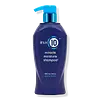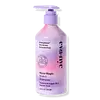What's inside
What's inside
 Key Ingredients
Key Ingredients

No key ingredients
 Benefits
Benefits

 Concerns
Concerns

 Ingredients Side-by-side
Ingredients Side-by-side

Water
Skin ConditioningSodium Cocoyl Isethionate
CleansingSodium C14-16 Olefin Sulfonate
CleansingAcrylates/Aminoacrylates/C10-30 Alkyl PEG-20 Itaconate Copolymer
Emulsion StabilisingCocamidopropyl Betaine
CleansingSodium Lauroamphoacetate
CleansingAcetic Acid
BufferingAloe Barbadensis Leaf Juice
Skin ConditioningAmodimethicone
Aspalathus Linearis Leaf Extract
Skin ConditioningButylene Glycol
HumectantC11-15 Pareth-7
EmulsifyingCitric Acid
BufferingCocamidopropyl Dimethylamine
EmulsifyingDextrin
AbsorbentDisodium EDTA
Euterpe Oleracea Fruit Extract
Glycereth-26
HumectantGlycerin
HumectantGlycol Distearate
EmollientGlycol Stearate
EmollientHelianthus Annuus Flower Extract
Skin ConditioningHydrolyzed Hibiscus Esculentus Extract
Skin ConditioningLaureth-9
EmulsifyingMagnesium Chloride
Magnesium Nitrate
Morinda Citrifolia Fruit Extract
Skin ConditioningMoringa Oleifera Seed Extract
Skin ConditioningParfum
MaskingPEG-10 Sunflower Glycerides
EmollientPEG-150 Pentaerythrityl Tetrastearate
EmulsifyingPEG-55 Propylene Glycol Oleate
PEG-6 Caprylic/Capric Glycerides
EmulsifyingPoly(C20-28 Olefin)
Skin ConditioningPolyquaternium-10
Propylene Glycol
HumectantPunica Granatum Fruit Extract
AntioxidantSodium Ascorbyl Phosphate
AntioxidantSodium Chloride
MaskingSodium Glycolate
BufferingSodium Hydroxide
BufferingSodium Lauroyl Sarcosinate
CleansingSodium Sulfate
Symphytum Officinale Leaf Extract
Skin ConditioningTetrasodium EDTA
Trideceth-12
EmulsifyingZingiber Officinale Root Extract
MaskingChlorphenesin
AntimicrobialEthylparaben
PreservativeMethylchloroisothiazolinone
PreservativeMethylisothiazolinone
PreservativeMethylparaben
PreservativePhenoxyethanol
PreservativePotassium Benzoate
PreservativePotassium Sorbate
PreservativeSodium Benzoate
MaskingCoumarin
PerfumingHexyl Cinnamal
PerfumingLimonene
PerfumingWater, Sodium Cocoyl Isethionate, Sodium C14-16 Olefin Sulfonate, Acrylates/Aminoacrylates/C10-30 Alkyl PEG-20 Itaconate Copolymer, Cocamidopropyl Betaine, Sodium Lauroamphoacetate, Acetic Acid, Aloe Barbadensis Leaf Juice, Amodimethicone, Aspalathus Linearis Leaf Extract, Butylene Glycol, C11-15 Pareth-7, Citric Acid, Cocamidopropyl Dimethylamine, Dextrin, Disodium EDTA, Euterpe Oleracea Fruit Extract, Glycereth-26, Glycerin, Glycol Distearate, Glycol Stearate, Helianthus Annuus Flower Extract, Hydrolyzed Hibiscus Esculentus Extract, Laureth-9, Magnesium Chloride, Magnesium Nitrate, Morinda Citrifolia Fruit Extract, Moringa Oleifera Seed Extract, Parfum, PEG-10 Sunflower Glycerides, PEG-150 Pentaerythrityl Tetrastearate, PEG-55 Propylene Glycol Oleate, PEG-6 Caprylic/Capric Glycerides, Poly(C20-28 Olefin), Polyquaternium-10, Propylene Glycol, Punica Granatum Fruit Extract, Sodium Ascorbyl Phosphate, Sodium Chloride, Sodium Glycolate, Sodium Hydroxide, Sodium Lauroyl Sarcosinate, Sodium Sulfate, Symphytum Officinale Leaf Extract, Tetrasodium EDTA, Trideceth-12, Zingiber Officinale Root Extract, Chlorphenesin, Ethylparaben, Methylchloroisothiazolinone, Methylisothiazolinone, Methylparaben, Phenoxyethanol, Potassium Benzoate, Potassium Sorbate, Sodium Benzoate, Coumarin, Hexyl Cinnamal, Limonene
Water
Skin ConditioningSodium Cocoyl Isethionate
CleansingCocamidopropyl Betaine
CleansingGlycerin
HumectantCocamidopropyl Hydroxysultaine
CleansingGlycol Distearate
EmollientAcrylates Copolymer
Cocamide Mipa
EmulsifyingArgania Spinosa Kernel Oil
EmollientHydrolyzed Adansonia Digitata Seed Extract
Hydrolyzed Vegetable Protein
Skin ConditioningPolyquaternium-10
Polyquaternium-7
Polyester-11
Skin ConditioningGuar Hydroxypropyltrimonium Chloride
Skin ConditioningTetrasodium Glutamate Diacetate
Aminomethyl Propanol
BufferingPotassium Sorbate
PreservativeSodium Benzoate
MaskingCitric Acid
BufferingPhenoxyethanol
PreservativeParfum
MaskingWater, Sodium Cocoyl Isethionate, Cocamidopropyl Betaine, Glycerin, Cocamidopropyl Hydroxysultaine, Glycol Distearate, Acrylates Copolymer, Cocamide Mipa, Argania Spinosa Kernel Oil, Hydrolyzed Adansonia Digitata Seed Extract, Hydrolyzed Vegetable Protein, Polyquaternium-10, Polyquaternium-7, Polyester-11, Guar Hydroxypropyltrimonium Chloride, Tetrasodium Glutamate Diacetate, Aminomethyl Propanol, Potassium Sorbate, Sodium Benzoate, Citric Acid, Phenoxyethanol, Parfum
Ingredients Explained
These ingredients are found in both products.
Ingredients higher up in an ingredient list are typically present in a larger amount.
Citric Acid is an alpha hydroxy acid (AHA) naturally found in citrus fruits like oranges, lemons, and limes.
Like other AHAs, citric acid can exfoliate skin by breaking down the bonds that hold dead skin cells together. This helps reveal smoother and brighter skin underneath.
However, this exfoliating effect only happens at high concentrations (20%) which can be hard to find in cosmetic products.
Due to this, citric acid is usually included in small amounts as a pH adjuster. This helps keep products slightly more acidic and compatible with skin's natural pH.
In skincare formulas, citric acid can:
While it can provide some skin benefits, research shows lactic acid and glycolic acid are generally more effective and less irritating exfoliants.
Most citric acid used in skincare today is made by fermenting sugars (usually from molasses). This synthetic version is identical to the natural citrus form but easier to stabilize and use in formulations.
Read more about some other popular AHA's here:
Learn more about Citric AcidCocamidopropyl Betaine is a fatty acid created by mixing similar compounds in coconut oil and dimethylaminopropylamine, a compound with two amino groups.
This ingredient is a surfactant and cleanser. It helps gather the dirt, pollutants, and other impurities in your skin to be washed away. It also helps thicken a product and make the texture more creamy.
Being created from coconut oil means Cocamidopropyl Betaine is hydrating for the skin.
While Cocamidopropyl Betaine was believed to be an allergen, a study from 2012 disproved this. It found two compounds in unpure Cocamidopropyl Betaine to be the irritants: aminoamide and 3-dimethylaminopropylamine. High-grade and pure Cocamidopropyl Betaine did not induce allergic reactions during this study.
Learn more about Cocamidopropyl BetaineGlycerin is already naturally found in your skin. It helps moisturize and protect your skin.
A study from 2016 found glycerin to be more effective as a humectant than AHAs and hyaluronic acid.
As a humectant, it helps the skin stay hydrated by pulling moisture to your skin. The low molecular weight of glycerin allows it to pull moisture into the deeper layers of your skin.
Hydrated skin improves your skin barrier; Your skin barrier helps protect against irritants and bacteria.
Glycerin has also been found to have antimicrobial and antiviral properties. Due to these properties, glycerin is often used in wound and burn treatments.
In cosmetics, glycerin is usually derived from plants such as soybean or palm. However, it can also be sourced from animals, such as tallow or animal fat.
This ingredient is organic, colorless, odorless, and non-toxic.
Glycerin is the name for this ingredient in American English. British English uses Glycerol/Glycerine.
Learn more about GlycerinGlycol Distearate serves as a pearlizing or opacifying agent in cosmetic products.
It's often included in cleansers and haircare products to give them a lustrous or shimmering appearance.
It is derived from stearic acid, a natural fatty acid commonly found in vegetable oils and animal fats.
Glycol Distearate isn't fungal acne safe.
Learn more about Glycol DistearateParfum is a catch-all term for an ingredient or more that is used to give a scent to products.
Also called "fragrance", this ingredient can be a blend of hundreds of chemicals or plant oils. This means every product with "fragrance" or "parfum" in the ingredients list is a different mixture.
For instance, Habanolide is a proprietary trade name for a specific aroma chemical. When used as a fragrance ingredient in cosmetics, most aroma chemicals fall under the broad labeling category of “FRAGRANCE” or “PARFUM” according to EU and US regulations.
The term 'parfum' or 'fragrance' is not regulated in many countries. In many cases, it is up to the brand to define this term.
For instance, many brands choose to label themselves as "fragrance-free" because they are not using synthetic fragrances. However, their products may still contain ingredients such as essential oils that are considered a fragrance by INCI standards.
One example is Calendula flower extract. Calendula is an essential oil that still imparts a scent or 'fragrance'.
Depending on the blend, the ingredients in the mixture can cause allergies and sensitivities on the skin. Some ingredients that are known EU allergens include linalool and citronellol.
Parfum can also be used to mask or cover an unpleasant scent.
The bottom line is: not all fragrances/parfum/ingredients are created equally. If you are worried about fragrances, we recommend taking a closer look at an ingredient. And of course, we always recommend speaking with a professional.
Learn more about ParfumPhenoxyethanol is a preservative that has germicide, antimicrobial, and aromatic properties. Studies show that phenoxyethanol can prevent microbial growth. By itself, it has a scent that is similar to that of a rose.
It's often used in formulations along with Caprylyl Glycol to preserve the shelf life of products.
Polyquaternium-10 is an ammonium salt of hydroxyethylcellulose. It is a white and granular powder used as a film-former and anti-static agent.
This ingredient is commonly found in hair conditioning products. According to a manufacturer, its positive charge makes it great for absorbing hair proteins. The manufacturer also states this ingredient helps with curl retention.
For haircare friends: this ingredient is not a silicone.
Learn more about Polyquaternium-10Potassium Sorbate is a preservative used to prevent yeast and mold in products. It is commonly found in both cosmetic and food products.
This ingredient comes from potassium salt derived from sorbic acid. Sorbic acid is a natural antibiotic and effective against fungus.
Both potassium sorbate and sorbic acid can be found in baked goods, cheeses, dried meats, dried fruit, ice cream, pickles, wine, yogurt, and more.
You'll often find this ingredient used with other preservatives.
Learn more about Potassium SorbateSodium Benzoate is a preservative. It's used in both cosmetic and food products to inhibit the growth of mold and bacteria. It is typically produced synthetically.
Both the US FDA and EU Health Committee have approved the use of sodium benzoate. In the US, levels of 0.1% (of the total product) are allowed.
Sodium benzoate works as a preservative by inhibiting the growth of bacteria inside of cells. It prevents the cell from fermenting a type of sugar using an enzyme called phosphofructokinase.
It is the salt of benzoic acid. Foods containing sodium benzoate include soda, salad dressings, condiments, fruit juices, wines, and snack foods.
Studies for using ascorbic acid and sodium benzoate in cosmetics are lacking, especially in skincare routines with multiple steps.
We always recommend speaking with a professional, such as a dermatologist, if you have any concerns.
Learn more about Sodium BenzoateSodium cocoyl isethionate is a natural ingredient from coconut oil. It is an ultra gentle cleanser that gives a nice foam without drying the skin or impacting the skin barrier.
The amount of foam created depends on the amount of sodium cocoyl isethionate used in the product.
This ingredient also helps improve the spreadability of a product.
Learn more about Sodium Cocoyl IsethionateWater. It's the most common cosmetic ingredient of all. You'll usually see it at the top of ingredient lists, meaning that it makes up the largest part of the product.
So why is it so popular? Water most often acts as a solvent - this means that it helps dissolve other ingredients into the formulation.
You'll also recognize water as that liquid we all need to stay alive. If you see this, drink a glass of water. Stay hydrated!
Learn more about Water